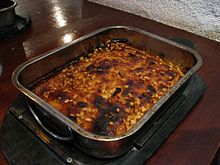Ore Mountain cuisine
This article includes a improve this article by introducing more precise citations. (February 2013) ) |
Cuisine in the
History
From the 12th century, with every berggeschrey (silver rush), the Ore Mountains experienced a fresh wave of immigrants. As a result, the cuisine of the region was subject to many influences from the lands in which the settlers originated. The 18th century, in particular, has left its mark on the dishes that are typical of the region today. When, in 1771–72, a period of great starvation arose for the last time in the mountains, the growing of potatoes was encouraged, even by the church in their so-called "tuber sermons" (Knollenpredigten). The potato plant thrived on the poor soils and harsh climate of the mountains and became the preferred food of the Ore Mountains. A variety of cooking methods was developed that still characterize today's traditional cuisine.
Typical dishes

Traditionally very common are various forms of potato pancake (Kartoffelpuffer) which may be served as sweet or savoury main courses as well as an accompaniment to meat. These especially include:
Fritters made of potato are also common, the best-known is the so-called Rauchemaad.
At Christmas, which is especially richly celebrated in the Ore Mountains, many households still make Neinerlaa. The ingredients vary from region to region, sometimes even from village to village. In any case, on Christmas Eve nine elements are served, for example, bratwurst, sauerkraut and lentils, each element supposedly having a special significance for the coming year. For example, dumplings stand for wealth and celery for fertility
Literature
- Uwe Schirmer: Ernährung im Erzgebirge im 15. und 16. Jahrhundert. Produktion, Handel und Verbrauch. In: Rainer Aurig, Steffen Herzog, Simone Lässig (ed.): Landesgeschichte in Sachsen. Tradition und Innovation (Studien zur Regionalgeschichte 10), Bielefeld, 1997, pp. 129–144 ISBN 3-89534-210-6
- Helmut Bräuer: Reflexionen über den Hunger im Erzgebirge um 1700. In: Manfred Hettling (ed.): Figuren und Strukturen: historische Essays für Hartmut Zwahr zum 65. Geburtstag, München: Saur, pp. 225–239 ISBN 3-598-11585-7
- Gotthard B. Schicker: Gutguschn - Das erste Kochbuch aus dem Erzgebirge. Annaberg-Buchholz, Verlag Erzgebirgs-Rundschau, 1991, (4th ed., 2005) ISBN 978-3-931770-761
- Ingeborg Delling: Holundersuppe und saure Schwamme: das kleine Kochbuch der Erzgebirger und Vogtländer. Chemnitzer Verlag, 1997 ISBN 3-928678-10-8
- Erzgebirgs-Verlag Häckel (pub.): Dr' arzgebirgsche Kochtopp – Alte Kochrezepte aus dem Erzgebirge. Oberwiesenthal, 2005 ISBN 3-9803680-6-8
- Roswitha Richter: Dr' arzgebirgsche Kochtopp 2: wieder entdeckt und aufbereitet. Erzgebirgs-Verlag Häckel, Oberwiesenthal, 2005 ISBN 3-9803680-6-8
- Ehrhardt Heinold: Ardäppelsupp und Zwiebelquark: die schönsten Rezepte aus dem Erzgebirge. Husum: Husum, 2006 ISBN 3-89876-261-0
- Ingeborg Delling: Grüne Kließ und Schwammebrüh: Kleines Kochbuch der Erzgebirger und Vogtländer. Chemnitzer Verlag, 2007 ISBN 978-3-937025-37-7
- Ehrhardt Heinold: Neunerlei und Gänsebraten: eine literarisch-kulinarische Reise ins Erzgebirge; mit einem erzgebirgischen Küchen-ABC. Husum: Verlag der Nation, 2009 ISBN 978-3-373-00531-5
